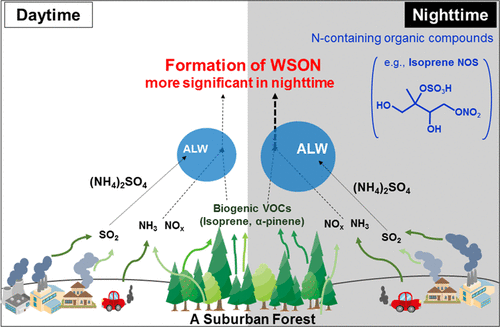当前位置:
X-MOL 学术
›
Environ. Sci. Technol.
›
论文详情
Our official English website, www.x-mol.net, welcomes your feedback! (Note: you will need to create a separate account there.)
Aerosol Liquid Water Promotes the Formation of Water-Soluble Organic Nitrogen in Submicrometer Aerosols in a Suburban Forest.
Environmental Science & Technology ( IF 11.4 ) Pub Date : 2020-01-21 , DOI: 10.1021/acs.est.9b05849 Yu Xu 1 , Yuzo Miyazaki 1 , Eri Tachibana 1 , Kei Sato 2 , Sathiyamurthi Ramasamy 2, 3 , Tomoki Mochizuki 1 , Yasuhiro Sadanaga 4 , Yoshihiro Nakashima 5 , Yosuke Sakamoto 2, 3, 6 , Kazuhide Matsuda 5 , Yoshizumi Kajii 2, 3, 6
Environmental Science & Technology ( IF 11.4 ) Pub Date : 2020-01-21 , DOI: 10.1021/acs.est.9b05849 Yu Xu 1 , Yuzo Miyazaki 1 , Eri Tachibana 1 , Kei Sato 2 , Sathiyamurthi Ramasamy 2, 3 , Tomoki Mochizuki 1 , Yasuhiro Sadanaga 4 , Yoshihiro Nakashima 5 , Yosuke Sakamoto 2, 3, 6 , Kazuhide Matsuda 5 , Yoshizumi Kajii 2, 3, 6
Affiliation

|
Water-soluble organic nitrogen (WSON) affects the formation, chemical transformations, hygroscopicity, and acidity of organic aerosols as well as biogeochemical cycles of nitrogen. However, large uncertainties exist in the origins and formation processes of WSON. Submicrometer aerosol particles were collected at a suburban forest site in Tokyo in summer 2015 to investigate the relative impacts of anthropogenic and biogenic sources on WSON formations and their linkages with aerosol liquid water (ALW). The concentrations of WSON (ave. 225 ± 100 ngN m-3) and ALW exhibited peaks during nighttime, which showed a significant positive correlation, suggesting that ALW significantly contributed to WSON formation. Further, the thermodynamic predictions by ISORROPIA-II suggest that ALW was primarily driven by anthropogenic sulfate. Our analysis, including positive matrix factorization, suggests that aqueous-phase reactions of ammonium and reactive nitrogen with biogenic volatile organic compounds (VOCs) play a key role in WSON formation in submicrometer particles, which is particularly significant in nighttime, at the suburban forest site. The formation of WSON associated with biogenic VOCs and ALW was partly supported by the molecular characterization of WSON. The overall result suggests that ALW is an important driver for the formation of aerosol WSON through a combination of anthropogenic and biogenic sources.
中文翻译:

气溶胶液态水促进郊区森林中亚微米气溶胶中水溶性有机氮的形成。
水溶性有机氮(WSON)影响有机气溶胶的形成,化学转化,吸湿性和酸性以及氮的生物地球化学循环。但是,WSON的起源和形成过程存在很大的不确定性。2015年夏季,在东京郊区的森林站点中收集了亚微米级气溶胶颗粒,以研究人为和生物源对WSON形成的相对影响及其与气溶胶液态水(ALW)的联系。WSON(平均225±100 ngN m-3)和ALW的浓度在夜间出现峰值,这表明存在显着的正相关,表明ALW显着促进了WSON的形成。此外,ISORROPIA-II的热力学预测表明,ALW主要由人为产生的硫酸盐驱动。我们的分析 包括正矩阵分解在内,表明铵和反应性氮与生物挥发性有机化合物(VOC)的水相反应在亚微米级颗粒的WSON形成中起关键作用,这在郊区森林站点的夜间尤为重要。与生物VOC和ALW相关的WSON的形成部分受到WSON分子表征的支持。总体结果表明,ALW是人为和生物来源相结合形成WSON气溶胶的重要驱动力。在郊区森林现场。与生物VOC和ALW相关的WSON的形成部分受到WSON分子表征的支持。总体结果表明,ALW是人为和生物来源相结合形成WSON气溶胶的重要驱动力。在郊区森林现场。与生物VOC和ALW相关的WSON的形成部分受到WSON分子表征的支持。总体结果表明,ALW是人为和生物来源相结合形成WSON气溶胶的重要驱动力。
更新日期:2020-01-22
中文翻译:

气溶胶液态水促进郊区森林中亚微米气溶胶中水溶性有机氮的形成。
水溶性有机氮(WSON)影响有机气溶胶的形成,化学转化,吸湿性和酸性以及氮的生物地球化学循环。但是,WSON的起源和形成过程存在很大的不确定性。2015年夏季,在东京郊区的森林站点中收集了亚微米级气溶胶颗粒,以研究人为和生物源对WSON形成的相对影响及其与气溶胶液态水(ALW)的联系。WSON(平均225±100 ngN m-3)和ALW的浓度在夜间出现峰值,这表明存在显着的正相关,表明ALW显着促进了WSON的形成。此外,ISORROPIA-II的热力学预测表明,ALW主要由人为产生的硫酸盐驱动。我们的分析 包括正矩阵分解在内,表明铵和反应性氮与生物挥发性有机化合物(VOC)的水相反应在亚微米级颗粒的WSON形成中起关键作用,这在郊区森林站点的夜间尤为重要。与生物VOC和ALW相关的WSON的形成部分受到WSON分子表征的支持。总体结果表明,ALW是人为和生物来源相结合形成WSON气溶胶的重要驱动力。在郊区森林现场。与生物VOC和ALW相关的WSON的形成部分受到WSON分子表征的支持。总体结果表明,ALW是人为和生物来源相结合形成WSON气溶胶的重要驱动力。在郊区森林现场。与生物VOC和ALW相关的WSON的形成部分受到WSON分子表征的支持。总体结果表明,ALW是人为和生物来源相结合形成WSON气溶胶的重要驱动力。


























 京公网安备 11010802027423号
京公网安备 11010802027423号